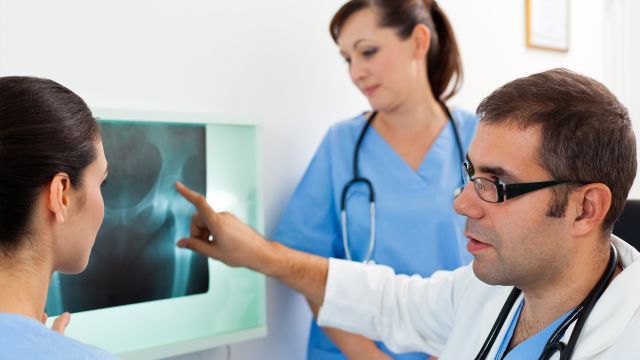While taking a fall and fracturing a hip can happen to anyone, nine out of 10 of the approximate 340,000 hip fractures suffered in the United States each year occur in people older than 65.
“The number one category for hip fractures is elderly patients, because their bones aren’t as strong and they have less overall health reserves,” says orthopedic surgeon Brian Larkin, MD, of Rose Medical Center. Hip fractures are overwhelmingly more common in women than in men; nearly three-quarters of hip fractures occur in women. “That’s likely related to higher incidences of osteoporosis and osteopenia,” says Dr. Larkin. “But that doesn’t mean men can’t have a hip fracture.”
It also doesn’t mean you have to be over 65. Hip replacement surgery, often due to hip injuries or arthritis, used to be relegated to people over 60. “Now we’re seeing young, active people in their 40s and 50s with advanced arthritis,” says Larkin. “People are saying I want the joint replaced so I can continue to live an active life,” Larkin says. “In my practice the average age [for hip replacement surgery] is closer to 50.”
Most other people who suffer hip fractures are victims of what Larkin calls “high-energy trauma” such as car accidents, being hit by a car or a fall from a height.
Older patients usually have a low-energy trauma event. “The majority of hip fractures we see in the elderly are just falls from standing height,” says Larkin. “They trip or stumble. It’s just one fall and a break. We’re not talking falling down the stairs here. It’s more like they just missed the last step.”
Hip fracture diagnosis
Your hip is a ball-and-socket joint that gives your leg a great deal of mobility. The end of your femur (the upper leg bone and the longest and heaviest bone in the body) fits into your pelvis, allowing your leg to swing back and forth and side to side. A hip fracture is damage to the upper portion of the femur. You’ll know you have a hip fracture because it will hurt any time you try to move your leg; your doctor can confirm if it’s fractured with X-rays.
Hip fracture treatment
Hip fractures usually require surgery, unless the patient isn’t healthy enough to recover from it. The type of surgery performed largely depends on which part of the femur is broken and what other tissues are damaged. The bone may be repaired using special nails, screws or plates. Some types of breaks don’t heal well, so partial or total hip replacement may be needed. Surgeons are often able to perform minimally invasive hip replacement surgery, making small incisions that require less cutting into muscle.
“Patients can, generally speaking, put their full weight on the leg right away,” Larkin says. “They’re home from the hospital in two or three days.” Larkin notes that a good percentage of people go to rehab afterwards. “Most people are doing okay after two to three months but continue to see improvements for a full year,” he says
When hip fractures are deadly
Suffering a hip fracture is especially dangerous for the elderly, since it can trigger a downward spiral of medical problems. If a patient is confined to bed the body weakens, compromising the immune system. Pneumonia and other infections can prove fatal or result in damage to the lungs and kidneys. Inactivity can cause blood clots, bedsores and further weakening of the bones, which may lead to more falls and fractures. Only about one in four elderly patients fully recover from a hip fracture, while approximately 20% die within a year of its occurrence.
A small 2017 study in the Journal of the American Geriatrics Society suggests that men may be more prone to cognitive impairment after a hip fracture. The men with the highest impairment also had the highest mortality rate at six months after the hip fracture—more than a quarter of these men died.
Fortunately, there are a number of ways to prevent hip fractures, especially if you’re at high-risk. Start with your bones. “Good bone and mineral metabolism is good,” says Larkin. “Get your bone density checked. Sometimes calcium and vitamin D supplements can help, and other medicines to help bone health.”
Other precautions to take:
- Check your home environment for trip and fall hazards. Do you have finicky rugs that often bunch up or fold over in the corners? Do you keep mail or shoes or purses on your stairs? If so, get rid of the offending items right away.
- Regular walking and weight-bearing exercises can help strengthen bones. Be sure to check with your doctor before starting any new exercise regimen.
- Both yoga and tai chi can improve balance and make you less susceptible to falls. This easy-to-follow routine can also help make you steady on your feet.






